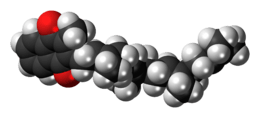Menatetrenone
Menatetrenone (INN), also known as MK-4, is a vitamin K compound used as a hemostatic agent, and also as adjunctive therapy for the pain of osteoporosis. Menatetrenone is one of the nine forms of vitamin K2.[1]
 | |
| Clinical data | |
|---|---|
| Other names | 3-methyl-2-[(2Z,6E,10E)-3,7,11,15-tetramethylhexadeca-2,6,10,14-tetraenyl]naphthalene-1,4-dione |
| AHFS/Drugs.com | International Drug Names |
| Routes of administration | Oral |
| ATC code |
|
| Identifiers | |
IUPAC name
| |
| CAS Number | |
| PubChem CID | |
| ChemSpider | |
| UNII | |
| KEGG | |
| ChEBI | |
| CompTox Dashboard (EPA) | |
| Chemical and physical data | |
| Formula | C31H40O2 |
| Molar mass | 444.648 g/mol g·mol−1 |
| 3D model (JSmol) | |
SMILES
| |
InChI
| |
| | |
MK-4 is produced via conversion of vitamin K1 in the body, in the testes, pancreas and arterial walls.[2] While major questions still surround the biochemical pathway for the transformation of vitamin K1 to MK-4, studies demonstrate the conversion is not dependent on gut bacteria, occurring in germ-free rats[3][4] and in parenterally-administered K1 in rats.[5][6] In fact, tissues that accumulate high amounts of MK-4 have a remarkable capacity to convert up to 90% of the available K1 into MK-4.[3][4]
Dose
Bioavailability studies have shown that small oral doses are not detected in the blood – for example 420 mcg of menatetrenone or less tested over minutes and hours are not detectable,[7] and larger doses in the order of milligrams are required, unlike Vitamin K2 MK-7 which is detectable in the blood in mcg doses. Furthermore, "administered daily doses of 15, 45, 90, and 135 mg revealed that 45 mg was the minimum effective dose for improving bone mass parameters evaluated by microdensitometry and/or single photon absorptiometry in postmenopausal women with osteoporosis".[8] The study referenced is also available in Japanese.[9][10] Briefly, four groups with doses of 15 mg, 45 mg, 90 mg, and 135 mg, and a 5th group with 0.75 mcg of alfacalcidol were evaluated. The counts of people who had a 'moderate improvement' or greater were recorded. The 15-mg group had 26.9%, the 45-mg – 46%, the 90-mg – 49%, and the 135-mg had 50.9% of subjects with a moderate improvement or greater. It was therefore determined that doses above 45 mg as much as 135 mg have the same effectiveness as 45 mg and that 45 mg was much better than 15 mg. Therefore, 45 mg was determined to be the ideal dose.
MK-4 is marketed for the osteoporosis indication in Japan by Eisai Co., under the trade name Glakay.
See also
- Vitamin K
- Phylloquinone (vitamin K1)
References
- Iwamoto J, Takeda T, Sato Y (December 2006). "Menatetrenone (vitamin K2) and bone quality in the treatment of postmenopausal osteoporosis". Nutr. Rev. 64 (12): 509–17. doi:10.1111/j.1753-4887.2006.tb00184.x. PMID 17274493.
- Shearer, Shearer MJ; Newman P. (2008). "Metabolism and cell biology of vitamin K". Thrombosis and Haemostasis. 100 (10): 530–547. doi:10.1160/TH08-03-0147. PMID 18841274.
- Davidson, RT; Foley AL; Engelke JA; Suttie JW (1998). "Conversion of Dietary Phylloquinone to Tissue Menaquinone-4 in Rats is Not Dependent on Gut Bacteria1". Journal of Nutrition. 128 (2): 220–223. doi:10.1093/jn/128.2.220. PMID 9446847.
- Ronden, JE; Drittij-Reijnders M-J; Vermeer C; Thijssen HHW (1998). "Intestinal flora is not an intermediate in the phylloquinone-menaquinone-4 conversion in the rat". Biochimica et Biophysica Acta (BBA) - General Subjects. 1379 (1): 69–75. doi:10.1016/S0304-4165(97)00089-5. PMID 9468334.
- Thijssen, HHW; Drittij-Reijnders MJ (1994). "Vitamin K distribution in rat tissues: dietary phylloquinone is a source of tissue menaquinone-4". British Journal of Nutrition. 72 (3): 415–425. doi:10.1079/BJN19940043. PMID 7947656.
- Will, BH; Usui Y; Suttie JW (1992). "Comparative Metabolism and Requirement of Vitamin K in Chicks and Rats". Journal of Nutrition. 122 (12): 2354–2360. doi:10.1093/jn/122.12.2354. PMID 1453219.
- Sato, Toshiro (Nov 12, 2012). "Comparison of menaquinone-4 and menaquinone-7 bioavailability in healthy women". Nutrition Journal. 11 (93): 93. doi:10.1186/1475-2891-11-93. PMC 3502319. PMID 23140417.
- Iwamoto, J (May 2014). "Vitamin K₂ therapy for postmenopausal osteoporosis". Nutrients. 6 (16): 1971–80. doi:10.3390/nu6051971. PMC 4042573. PMID 24841104.
- 折茂肇 、藤田拓男 、小野村敏信 (June 1992). "骨粗しょう症に対するメナテトレノン軟カプセル剤(Ea‐0167)の臨床効果 後期第II相用量検討試験". 新薬と臨床. 41 (6): 1249–1279.
- "医薬品インタビューフォーム" [Pharmaceutical interview form]. Glakay. Archived from the original on 8 May 2018. Retrieved 5 July 2018.
External links
- Product information: "Glakay" (PDF). Eisai Co. November 2009. Retrieved 2012-01-10.